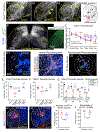Modulation of central synapse remodeling after remote peripheral injuries by the CCL2-CCR2 axis and microglia
- PMID: 38367237
- PMCID: PMC10947500
- DOI: 10.1016/j.celrep.2024.113776
Modulation of central synapse remodeling after remote peripheral injuries by the CCL2-CCR2 axis and microglia
Abstract
Microglia-mediated synaptic plasticity after CNS injury varies depending on injury severity, but the mechanisms that adjust synaptic plasticity according to injury differences are largely unknown. This study investigates differential actions of microglia on essential spinal motor synaptic circuits following different kinds of nerve injuries. Following nerve transection, microglia and C-C chemokine receptor type 2 signaling permanently remove Ia axons and synapses from the ventral horn, degrading proprioceptive feedback during motor actions and abolishing stretch reflexes. However, Ia synapses and reflexes recover after milder injuries (nerve crush). These different outcomes are related to the length of microglia activation, being longer after nerve cuts, with slower motor-axon regeneration and extended expression of colony-stimulating factor type 1 in injured motoneurons. Prolonged microglia activation induces CCL2 expression, and Ia synapses recover after ccl2 is deleted from microglia. Thus, microglia Ia synapse removal requires the induction of specific microglia phenotypes modulated by nerve regeneration efficiencies. However, synapse preservation was not sufficient to restore the stretch-reflex function.
Keywords: C-C chemokine; CP: Immunology; CP: Neuroscience; Ia afferent; colony stimulating factor 1; motoneuron; nerve injury; neuroinflammation; regeneration; stretch reflex; synapse.
Copyright © 2024 The Author(s). Published by Elsevier Inc. All rights reserved.
Conflict of interest statement
Declaration of interests The authors have no competing interests.
Figures







Similar articles
-
Spinal Motor Circuit Synaptic Plasticity after Peripheral Nerve Injury Depends on Microglia Activation and a CCR2 Mechanism.J Neurosci. 2019 May 1;39(18):3412-3433. doi: 10.1523/JNEUROSCI.2945-17.2019. Epub 2019 Mar 4. J Neurosci. 2019. PMID: 30833511 Free PMC article.
-
Massive Loss of Proprioceptive Ia Synapses in Rat Spinal Motoneurons after Nerve Crush Injuries in the Postnatal Period.eNeuro. 2023 Feb 16;10(2):ENEURO.0436-22.2023. doi: 10.1523/ENEURO.0436-22.2023. Print 2023 Feb. eNeuro. 2023. PMID: 36759186 Free PMC article.
-
Permanent central synaptic disconnection of proprioceptors after nerve injury and regeneration. I. Loss of VGLUT1/IA synapses on motoneurons.J Neurophysiol. 2011 Nov;106(5):2450-70. doi: 10.1152/jn.01095.2010. Epub 2011 Aug 10. J Neurophysiol. 2011. PMID: 21832035 Free PMC article.
-
Synaptic Plasticity on Motoneurons After Axotomy: A Necessary Change in Paradigm.Front Mol Neurosci. 2020 Apr 30;13:68. doi: 10.3389/fnmol.2020.00068. eCollection 2020. Front Mol Neurosci. 2020. PMID: 32425754 Free PMC article. Review.
-
The Role of Microglia in Neuroinflammation of the Spinal Cord after Peripheral Nerve Injury.Cells. 2022 Jun 30;11(13):2083. doi: 10.3390/cells11132083. Cells. 2022. PMID: 35805167 Free PMC article. Review.
Cited by
-
CC Chemokine Family Members' Modulation as a Novel Approach for Treating Central Nervous System and Peripheral Nervous System Injury-A Review of Clinical and Experimental Findings.Int J Mol Sci. 2024 Mar 28;25(7):3788. doi: 10.3390/ijms25073788. Int J Mol Sci. 2024. PMID: 38612597 Free PMC article. Review.
-
Microglia-derived CXCL2 induced neuronal ferroptosis via CXCR2/Jun axis in sepsis-associated encephalopathy.Front Immunol. 2025 Mar 6;15:1512300. doi: 10.3389/fimmu.2024.1512300. eCollection 2024. Front Immunol. 2025. PMID: 40115159 Free PMC article.
References
Publication types
MeSH terms
Substances
Grants and funding
LinkOut - more resources
Full Text Sources
Molecular Biology Databases
Research Materials
Miscellaneous

